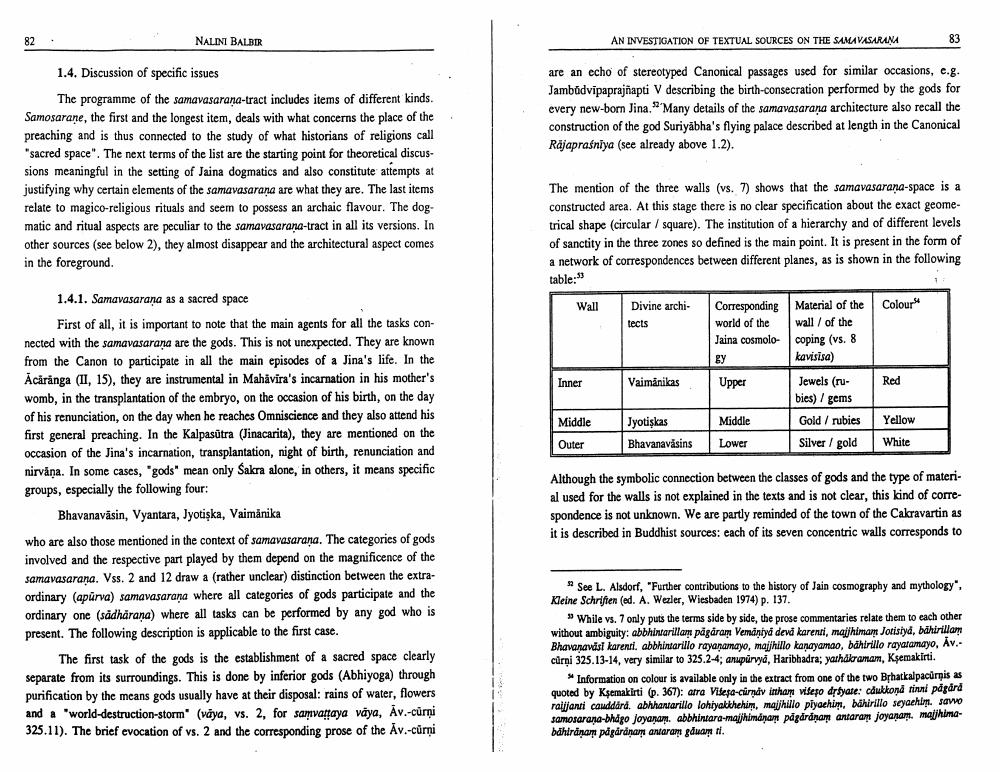Book Title: An Investigation Of Textual Sources On Samavasarana Author(s): Nalini Balbir Publisher: Nalini Balbir View full book textPage 9
________________ 82 . NALINI BALBIR AN INVESTIGATION OF TEXTUAL SOURCES ON THE SAMAVASARANA 83 are an echo of stereotyped Canonical passages used for similar occasions, c.g. Jambódvipaprajnapti V describing the birth-consecration performed by the gods for every new-born Jina." Many details of the samavasarana architecture also recall the construction of the god Suriyabha's flying palace described at length in the Canonical Rajapraśniya (see already above 1.2). 1.4. Discussion of specific issues The programme of the samavasarana-tract includes items of different kinds. Samosarane, the first and the longest item, deals with what concerns the place of the preaching and is thus connected to the study of what historians of religions call "sacred space". The next terms of the list are the starting point for theoretical discussions meaningful in the setting of Jaina dogmatics and also constitute attempts at justifying why certain elements of the samavasarana are what they are. The last items relate to magico-religious rituals and seem to possess an archaic flavour. The dog matic and ritual aspects are peculiar to the samavasarana-tract in all its versions. In other sources (see below 2), they almost disappear and the architectural aspect comes in the foreground. The mention of the three walls (vs. 7) shows that the samavasarana-space is a constructed area. At this stage there is no clear specification about the exact geometrical shape (circular / square). The institution of a hierarchy and of different levels of sanctity in the three zones so defined is the main point. It is present in the form of a network of correspondences between different planes, as is shown in the following table: Wall Colour Divine architects Corresponding world of the Jaina cosmolo Material of the wall / of the coping (vs. 8 kavisisa) Inner Vaimānikas Upper Red Jewels (rubies) / gems Gold / rubies Yellow Middle Outer Jyotiskas Bhavanavasins Middle Lower Silver / gold White 1.4.1. Samavasarana as a sacred space First of all, it is important to note that the main agents for all the tasks connected with the samavasarana are the gods. This is not unexpected. They are known from the Canon to participate in all the main episodes of a Jina's life. In the Acårånga (II, 15), they are instrumental in Mahavira's incarnation in his mother's womb, in the transplantation of the embryo, on the occasion of his birth, on the day of his renunciation, on the day when he reaches Omniscience and they also attend his first general preaching. In the Kalpasūtra (Jinacarita), they are mentioned on the occasion of the Jina's incarnation, transplantation, night of birth, renunciation and nirväņa. In some cases, "gods" mean only Sakra alone, in others, it means specific groups, especially the following four: Bhavanaväsin, Vyantara, Jyotiska, Vaimanika who are also those mentioned in the context of samavasarana. The categories of gods involved and the respective part played by them depend on the magnificence of the samavasarana. Vss. 2 and 12 draw a (rather unclear) distinction between the extraordinary (apūrva) samavasarana where all categories of gods participate and the ordinary one (sadharana) where all tasks can be performed by any god who is present. The following description is applicable to the first case. The first task of the gods is the establishment of a sacred space clearly separate from its surroundings. This is done by inferior gods (Abhiyoga) through purification by the means gods usually have at their disposal: rains of water, flowers and a "world-destruction-storm' (vaya, vs. 2, for samvattaya vaya, Av.-cúrņi 325.11). The brief evocation of vs. 2 and the corresponding prose of the Av.-curņi Although the symbolic connection between the classes of gods and the type of material used for the walls is not explained in the texts and is not clear, this kind of correspondence is not unknown. We are partly reminded of the town of the Cakravartin as it is described in Buddhist sources: each of its seven concentric walls corresponds to * See L. Alsdorf, "Further contributions to the history of Jain cosmography and mythology, Kleine Schriften (ed. A. Wezler, Wiesbaden 1974) p. 137. » While vs. 7 only puts the terms side by side, the prose commentaries relate them to each other without ambiguity: abbhintarillam pågåram Venantyd devd karenti, majjhima Jorislyd, bihirilla Bhavanavdsl karenri, abbhintarillo rayanamayo, malihillo kanayamao. bähirillo rayatamayo, Av.cúrni 325.13-14, very similar to 325.2-4; anupürvya, Haribhadra; yashdkramam, Ksemakirti. Information on colour is available only in the extract from one of the two Bohatkalpacurpis as (p. 367): atra Viesa-candy intham wifeso dryase: cdukkoná tinni pdgard ralijanti caudara. abhhantarillo lohiyakkhehim, majjhillo piyachim, bähirillo seyachim. savo samosarana-bhago Joyanam. abbhintara-majjhimánam pagaranam antaram joyana, mahimabahiranom pågåranam antaram gauan ti.Page Navigation
1 ... 7 8 9 10 11 12 13 14 15 16 17 18 19 20
